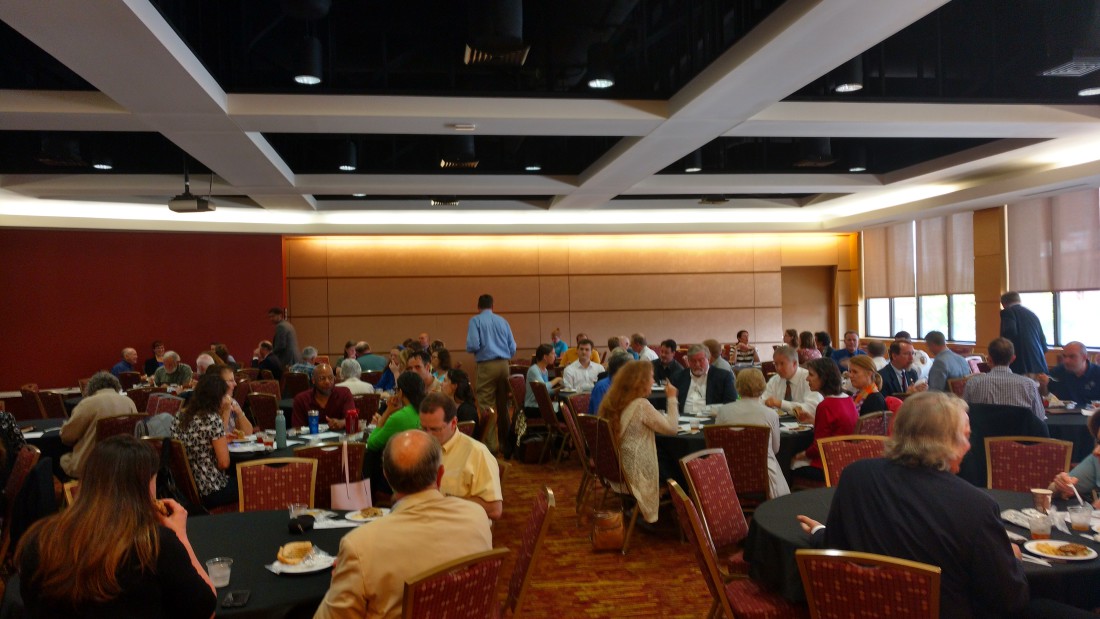Legendary rock group Chicago — the first band Interim City Manager Cathy Ball ever saw in concert — is scheduled for a show this Sunday at the U.S. Cellular Center, but it was Ball and her staff who took the stage on May 17. At the spring city manager’s development forum in the arena’s Banquet Hall, Asheville employees shared updates for the city’s planning and construction community.
As roughly 80 attendees enjoyed a city-catered lunch of sandwiches and pasta salad from Roman’s Deli, Director of Development Services Ben Woody outlined trends in issued construction permits and their estimated monetary value. Both of these values, he said, were lower in 2018 than in the previous year: Roughly 400 residential and 260 commercial permits were issued in fiscal year 2017, with a total value of $657 million, while the current fiscal year is projected to see approximately 300 residential and 200 commercial permits, with a total value of $277 million.
However, Woody noted that last year was “a little bit of an outlier” due to the approval of Mission Health’s Mission Hospital for Advanced Medicine, colloquially known as the Mission tower. Omitting that construction, Woody said, the total value of issued permits for 2017 was closer to $417 million. He also suggested that pending permits would raise the actual 2018 value later in the year.
Woody provided an update on the Development Services Department’s efforts to improve customer service. Much of this approach revolves around online permit applications, which Woody said now represent 19 percent of the total, close to his department’s goal from the 2017-2018 budget. He noted that online applications could ease the stress on the department’s physical lobby at the Development Center on South Charlotte Street, which processes roughly 80 customer visits every day.

The department’s fee schedule will also change as of July 1. While more details will become available in early June, Woody explained that the priorities for fee revisions were simplicity and cost recovery, with a focus on “horizontal development” services such as planning, zoning and site development. That increase, he added, will allow the department to continue building online tools for better service.
“We were very cognizant of not adversely impacting affordable housing, small businesses, individual lot owners,” Woody said. “We wanted to make sure the fee increases, with Council’s guidance, were strategic and aligned with their goals.”
Mark Matheny, chief code official and building division manager, followed on Woody’s presentation with more detail on the department’s customer service improvements. A collaborative staff “LEAN team,” he said, had reviewed the permitting process with an ideal goal of issuing a permit within five days of application. “Everybody’s chuckling,” he noted about the audience’s response, saying the current average wait was closer to 15 or 21 days.
But Matheny said that in a perfect world, his staff could approve a permit in six days. The biggest obstacle to that timeline, he explained, has been a lack of clarity in the city’s requirements for permit applicants.
“When you come in, do you know exactly what we want?” Matheny asked. “We don’t have a clear expectation. We say, ‘We’ll give you a permit if you give us everything.’ And then you say, ‘What is everything?’ Well, it’s what I have in my head, but I can’t get that out to you.”
By identifying a basic set of information needed for all permits and creating a new requirement checklist, staff hope to mitigate the problems that occur at the beginning of the permit process. Matheny added that the city is moving toward a digital plan review solution, with a system set to be adopted in the near future after test modeling.
“This technology fee [4 percent added to most development services fees] is allowing us to actually move into this century and this process and keep up with what the community is doing,” Matheny said.
Planning & Urban Design Assistant Director Alan Glines presented the final draft of the city’s comprehensive plan. Titled “Living Asheville: A Comprehensive Plan for Our Future,” the document sets forth Asheville’s aspirations, goals and strategies for development through 2036 (avl.mx/4z6).
Although nearly 400 pages in length, the comprehensive plan focuses around just six major themes: livable built environment, resilient economy, harmony with the natural environment, healthy community, interwoven equity and responsible regionalism. Glines hopes for the plan to make its way through the Planning & Zoning Commission and City Council within the next four to six weeks.
Of particular interest to Asheville’s development community, Glines noted, is the comprehensive plan’s future land use map. Highlights include increased mixed-use development along transit corridors, more intensive downtown development (including housing) and dense “town centers” in locations such as Biltmore Village and the Asheville Mall that combine residential and business functions.
Glines added that Asheville’s growth — an estimated 16,000 additional residents by 2030 — will demand careful attention to transit issues. “[Our] transit future means that we’re providing multimodal access,” he said. “We can’t expand every road to solve every car issue, so it’s got to be multimodal.”




Did they remind the attendees that City Council recently stole $4.2 Million from the taxpayers and just GAVE it to the already funded Housing Authority of Asheville for more ghetto creation ? Then,
your County Commissioners matched them for a total of $8.4 Million stolen from the taxpayers without a vote to further fund the biggest problem in Asheville, run by segregationist democrackkks.